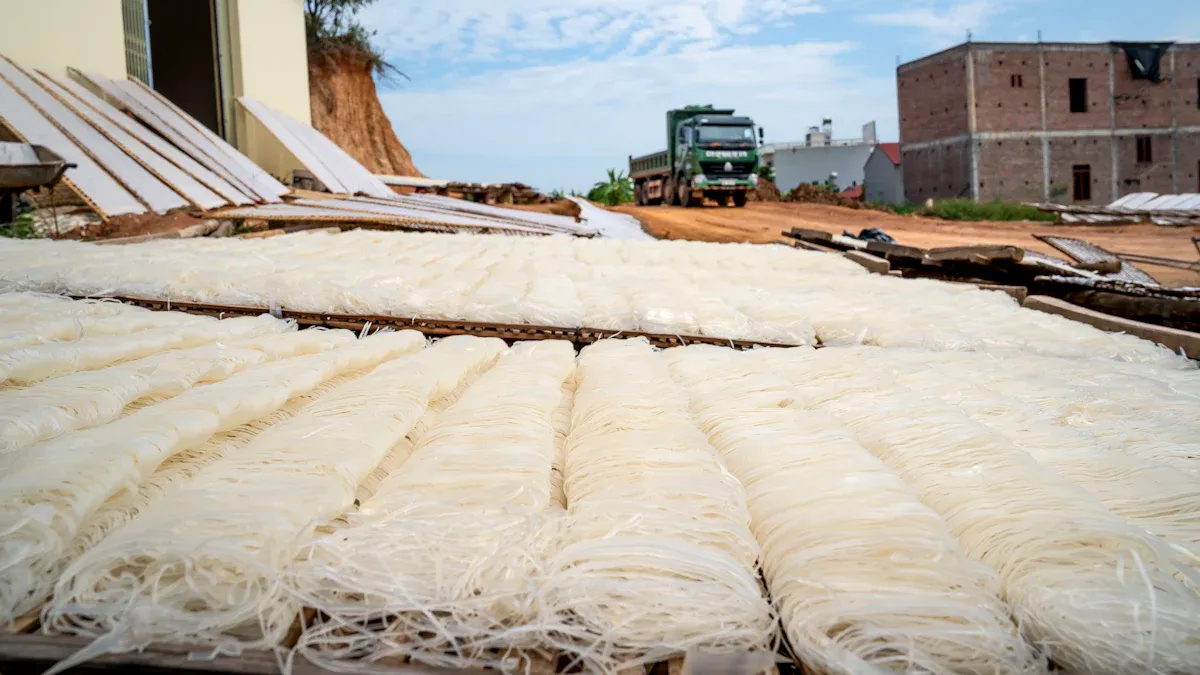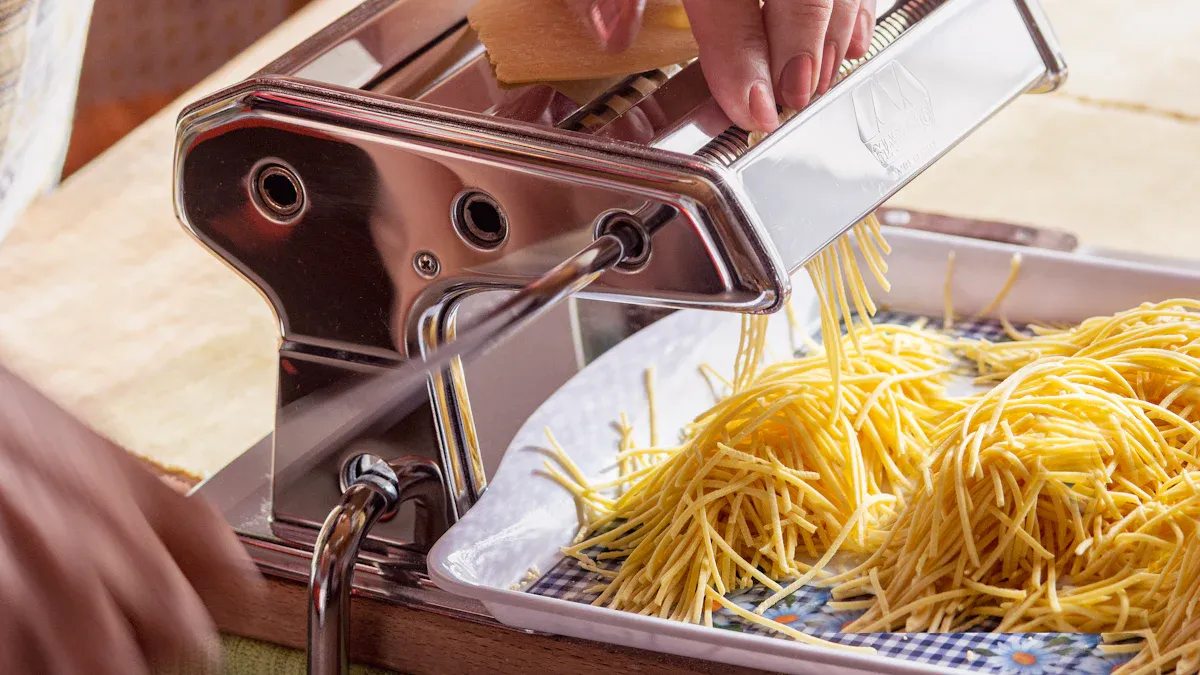English 





Views: 0 Author: Site Editor Publish Time: 2025-07-23 Origin: Site









The instant noodle production line in 2025 uses new machines. These machines turn raw materials into noodles very fast. Factories use smart automation to make each step exact and quick. Robots and sensors check each batch for good quality. These changes help companies make more noodles and waste less. Modern equipment shapes, cooks, and packs noodles very well.
New machines and robots help make instant noodles quickly and safely in 2025.
Automation and sensors watch each step to keep noodles the same.
Factories use smart systems to cut down waste and save energy.
Different ways are used to make fried and non-fried noodles for customers.
Data tracking lets factories fix problems fast and keep noodles fresh.
The instant noodle production line in 2025 is fully automated. Its main job is to make instant noodles fast and safe. Factories everywhere use this system to keep up with demand. Top companies in China, Japan, and South Korea send noodles to many countries.
The instant noodle production line has many steps:
Ingredient preparation: Workers or machines measure and mix flour, water, and other things.
Dough mixing and sheeting: Machines knead the dough and roll it flat.
Noodle forming and cutting: Cutters shape the dough into noodles.
Steaming: Steamers cook the noodles so they are even.
Frying or drying: Some lines fry noodles in oil, others dry them with hot air.
Cooling: Cooling systems make the noodles less hot.
Seasoning and packaging: Machines add flavor and pack the noodles for shipping.
Note: Special machines help each step stay fast and clean.
In 2025, factories use robots and sensors in the instant noodle production line. These machines check each batch for quality. Automated arms move noodles between machines without people. Smart sensors look for problems and send alerts if needed. Data systems watch every step of making noodles. This technology helps companies make more noodles and waste less. It also keeps noodles safe and fresh for people everywhere.
In 2025, factories use new machines and strong quality checks. Every step helps make noodles that taste good and are safe. The process starts with raw ingredients. It ends with cooked noodles ready for the next step.
Factories pick good flour, water, salt, and other things. Workers or machines weigh each part to fit the recipe. Some factories use feeders to add flour and water to big bowls. This step is important because the right mix gives noodles their taste and feel.
Tip: Measuring ingredients well keeps every batch the same.
After weighing, machines mix everything to make dough. Big mixers spin and knead the dough until it is smooth. The dough goes to a sheeter next. The sheeter presses the dough into thin sheets. Even thickness helps noodles cook the same later.
A table below shows the main machines for this step:
| Step | Machine Used | Purpose |
|---|---|---|
| Mixing | Dough Mixer | Mixes ingredients into dough |
| Sheeting | Dough Sheeter | Flattens dough into sheets |
Next, rollers cut the dough sheets into long noodle strands. Some machines use blades to make wavy or straight noodles. The shape and size depend on the noodle type. The cutters work fast and keep noodles the same length.
Note: Cutting noodles the same way helps them cook evenly.
The noodle strands go into a steamer. Hot steam cooks the noodles fast and evenly. Steaming sets the noodle shape and takes away any raw taste. Modern steamers use sensors to check heat and time. This step gets noodles ready for frying or drying next.
Mixers, sheeters, cutters, and steamers help make noodles. These machines help factories make noodles that look and taste the same. Each step needs to be careful for good noodles.

The instant noodle production line in 2025 makes two main noodle types. These are fried noodles and non-fried noodles. Fried noodles have a strong taste and a special feel. Non-fried noodles use less oil and feel lighter to eat. Factories pick the best way to make noodles for their customers.
The fried instant noodle production line uses new fryers. These fryers dip noodle blocks in hot oil for a short time. The oil cooks the noodles fast and makes them crispy. Sensors check the oil heat and how long noodles fry. This helps every batch turn out the same. Robots move noodle blocks in and out of the fryer. This keeps the process clean and safe.
Factories save energy by using heat recovery systems. These systems use heat from the fryer to warm new oil or water. This helps lower costs and is better for the environment.
A table below shows some main features of new frying technology:
| Feature | Benefit |
|---|---|
| Oil temperature control | Even cooking |
| Automated handling | Faster production |
| Heat recovery | Energy savings |
Non-fried noodles do not go into oil. They dry with hot air instead. This takes water out of the noodles but does not add fat. Non-fried noodles are good for people who want a healthier meal. Factories use big dryers with moving belts. These belts keep noodles moving so they dry the same.
Note: Non-fried noodles taste and feel different from fried ones, but both types use the same instant noodle production line until the drying step.

Today’s instant noodle factories use smart machines for cooling, seasoning, and packaging. These steps help noodles stay fresh and taste good. Each part works together so the line does not stop. This lets factories make more noodles every day.
Noodles are hot after frying or drying. Cooling systems make them cool fast. Conveyor belts carry noodles through cool air tunnels. Fans blow air to take away heat. This stops noodles from sticking or getting soggy. Some factories use sensors to check the heat. If noodles are too hot, the line slows down. This keeps noodles tasting and feeling right.
Tip: Cooling noodles well helps them last longer.
Seasoning gives noodles their special taste. Machines put seasoning on the noodles. Some use powder, others use liquid sauce. The system adds the right amount each time. This makes sure every pack tastes the same. Factories can change flavors for different places. For example, some countries get spicy, others get mild.
A table below shows how factories add seasoning:
| Method | Example Use |
|---|---|
| Powder Sprinkler | Chicken flavor |
| Liquid Sprayer | Soy sauce flavor |
Packaging machines wrap noodles and seasoning together. Robots put noodles into bags or cups. Machines seal each pack to keep out air and water. Some lines can use different bag sizes or shapes. This helps factories sell noodles in many places. Labels and codes go on each pack for safety. The whole system works without stopping to save time and avoid mistakes.
Note: Automated packaging keeps noodle making fast and clean.
Modern instant noodle factories use new inspection systems. These systems check noodles at each step. Cameras and sensors look for broken noodles or color changes. They also check for missing pieces. Robots take out noodles that do not meet standards. This helps factories keep only good noodles for packing.
Factories use in-line inspection to find problems early. This keeps the production line working well.
A normal inspection system has:
High-speed cameras for checking how noodles look
Metal detectors for safety reasons
Weight sensors to make sure each pack is right
These tools help factories give safe and high-quality noodles to people.
Factories in 2025 use data to make noodles better. Each batch of noodles gets its own code. Computers track every step from mixing to packing. If there is a problem, workers can find out where it started.
A table below shows how data helps track noodles:
| Step | Data Collected | Purpose |
|---|---|---|
| Mixing | Ingredient amounts | Recipe control |
| Frying/Drying | Time, temperature | Cooking consistency |
| Packaging | Batch codes, weight | Product tracking |
Data analytics help factories see trends and fix problems fast. This keeps noodles safe and fresh for everyone.
Sustainability is important in noodle making. Factories now use less water and energy. Many lines reuse heat from fryers and dryers. Some companies use packaging that breaks down faster in nature.
Tip: Reducing waste helps both the factory and the planet.
Factories try to use all parts of the raw materials. Leftover dough can be animal feed or compost. These actions lower costs and help the environment. In 2025, instant noodle factories work hard to make food production greener.
In 2025, factories use new machines for each step.
Robots and smart sensors help make noodles fast and safe.
Quality checks and data systems keep every batch the same.
Factories use less energy and make less waste with new tech.
Today’s instant noodle production uses technology and careful work together. Thanks to these changes, people everywhere get safe and tasty noodles.
Factories use robots and sensors to check noodles all the time. Cameras watch for noodles that are broken. Metal detectors look for things that should not be there. Workers take out noodles that are not good enough. This makes sure every pack is safe for people.
Non-fried noodles dry with hot air, not oil. This way, the noodles have less fat. People who want a lighter meal pick non-fried noodles. Factories use special dryers to keep noodles tasty and safe.
Yes! Machines can cut noodles into many shapes, like wavy or straight. Factories use different seasonings for each place. Some countries get spicy flavors, and others get mild ones.
Factories use leftover dough for animal feed or compost. They also use heat recovery systems to save energy. Many companies choose packaging that breaks down faster in nature. These steps help protect the environment.